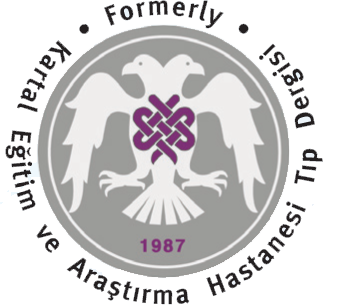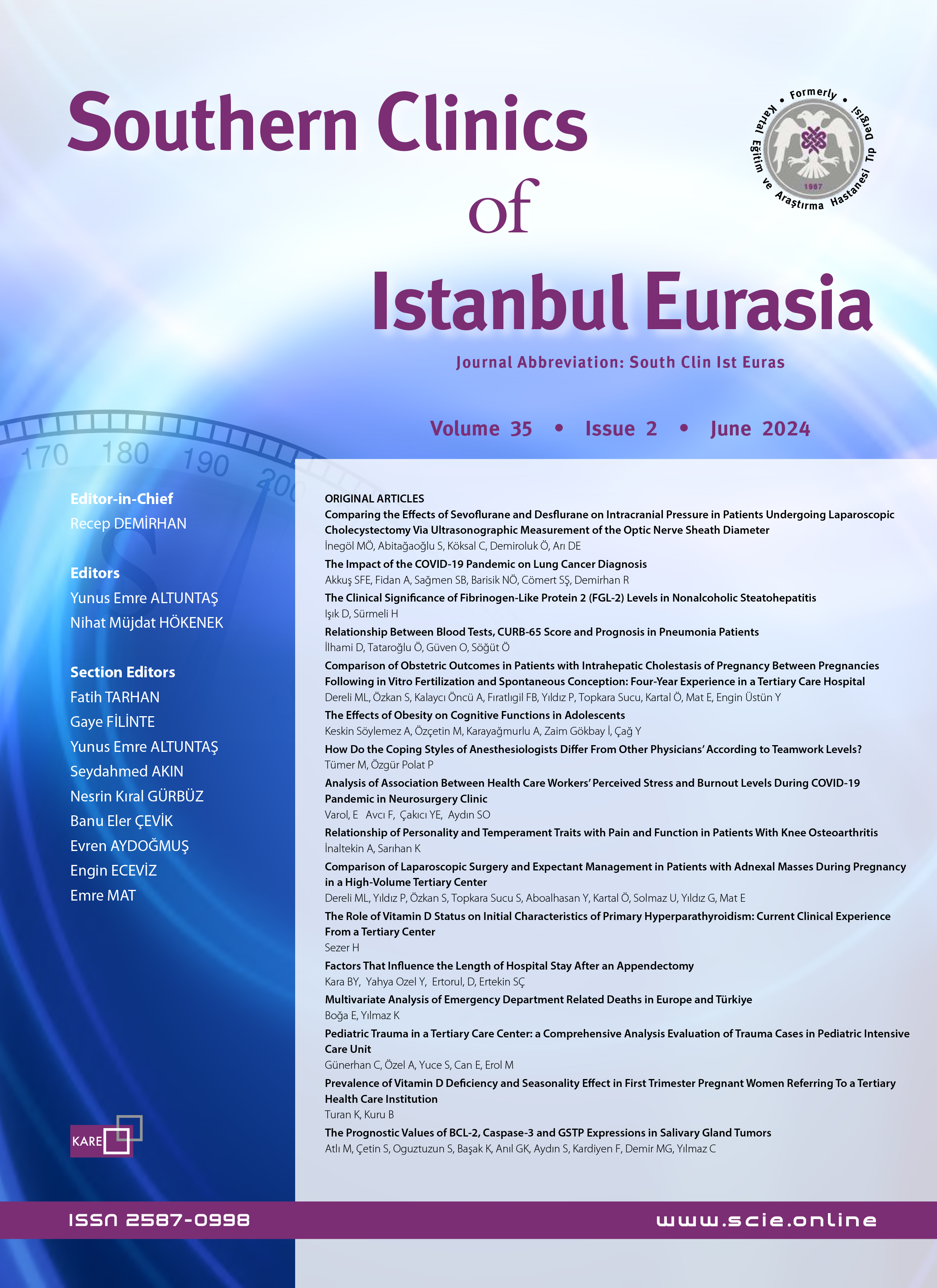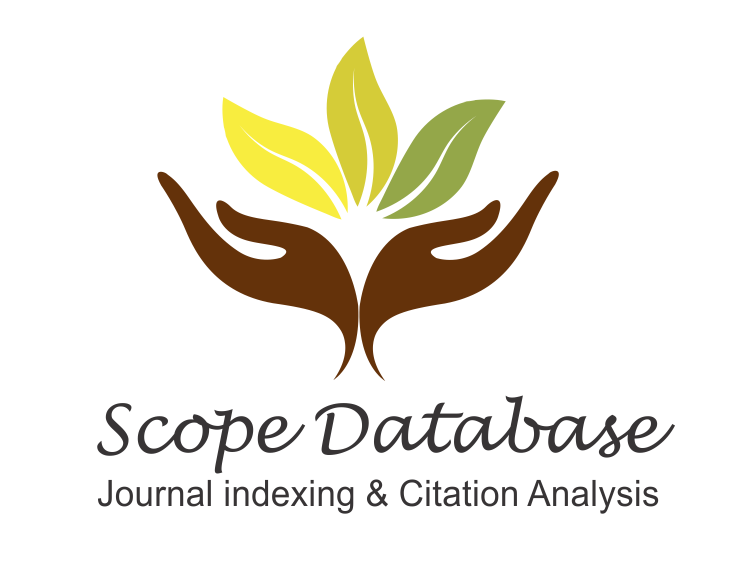Volume: 19 Issue: 2 - 2008
| RESEARCH ARTICLE | |
| 1. | Approach to parotid gland tumors Sedat Aydın, Alev Zeynep Oktay, Mustafa Paksoy, Mehmet Eken, Arif Şanlı, Sermin Kibar Pages 57 - 61 OBJECTIVE: In this study we presented our results about distribution of anatomic and histopathological properties of parotid gland tumors and treatment modality of these tumors. METHODS: Fiftytwo parotid tumor patients who underwent parotid gland surgery between november 2001 - september 2008 in Dr.Lutfi Kirdar Kartal training and research hospital 2 nd ENT clinic were included in this study. Age, sex, clinical signs and symptoms, histopatological diagnosis, complications, tumor stage and prognosis of these 52 patients evaluated retrospectively. RESULTS: Histopathological results of 23 female and 29 male patients aged between 15-77 years underwent parotid gland surgery because of parotid gland mass were 6 chronic inflammatory disease, 41 benign tumor and 5 malign tumor. We performed total parotidectomy for patients who had malign tumor or benign tumor localized in deep lobe and superficial parotidectomy for the others. Also for some of the malign tumors, additional treatment modalities performed like neck dissection and chemoradiotheraphy. CONCLUSION: Superficial parotidectomy is still a preferable treatment modality in most of the parotid gland tumors and neck dissection is controversial in N0 and M0 patients. Fine needle aspiration biopsy is helpful and important diagnostic technic in preoperative evaluation. |
| 2. | Ahmed Glaucoma Valve implantation in refractory glaucoma Berker Bakbak, Güldal Ersoy, Feyza Önder Pages 62 - 66 OBJECTIVE: To evaluate the efficacy of Ahmed Glaucoma Valve (AGV) implantation in reducing intraocular pressure in glaucoma, resistant to medical therapy and/or glaucoma filtration surgery. METHODS: Twenty one eyes of 21 patients who underwent AGV implantation were retrospectively evaluated. AGV were implanted for neovascular glaucoma in 12 (57%) cases, secondary glaucomas in 8 (38%) cases and congenital glaucoma in 1 (5%) case. Success of surgery was defined as an intraocular pressure less than 22 mmHg and greater than 5 mmHg with or without medical treatment. RESULTS: The mean follow up of 21 patients (11 male, 10 female) was 17 (3-35 months) and the mean age was 47.1 (7-88 years). Intraocular pressure was reduced from a mean of 36.3±9.62 mmHg before surgery to 15.6±3.97 mmHg at the last follow-up after surgery. Postoperative complications were hyphema in 4 (19%) cases, encapsulation in 3 (14.2) cases, shallow anterior chamber in 2 (9.5%) cases, fascia melting in 2 (9.5%) cases, tube occlusion in 2 (9.5%) cases, short tube in anterior chamber in 1 (4.7%) case and choroidal detachment in 1 (4.7%) case. Sufficient intraocular pressure were obtained in 19 patients with 90.5% ratio. CONCLUSION: Ahmed Glaucoma Valve can be an effective and safe method in cases which conventional filtration surgery seem to be insufficent in the management of refractory glaucoma. |
| 3. | Efficiency of transforaminal epidural steroid treatment in chronic low back pain Hüsnü Süslü, Elif Atar, Gülten Arslan, İzzet Alatlı, Murat Altun, Serhan Çolakoğlu Abraz Pages 67 - 72 OBJECTIVE: The pain of the patients can be decreased with a big percentage with minimal invasive applications in lomber disc hernias which causes radiculopathic symptoms. Transforaminal epidural steroid application is one of these methods. We aim to evaluate transforaminal steroid efficiency as retrospective in lomber disk hernia cases which has radiculopathic semptoms. METHODS: The files of the 125 patients (40 males, 85 females) which applied transforaminal epidural steorid injection between the dates of January 2007 and May 2008 were examined retrospectively. Visual Analogue Scale (VAS), straight leg lifting test, hand-finger straight ground distance and patient pleasure scores were appreciated. RESULTS: It is observed that there is a meaningful improvement when VAS, straight leg lifting test, hand-finger straight ground distance compared with the the value of the enterprise before transforaminal epidural steroid application. CONCLUSION: Transforaminal epidural steroid application is a good method which can be performed in cronic low back pain triumphantly. |
| 4. | Effects of glycemic control on diabetic cardiovascular autonomic neuropathy Selçuk Turan, İsmet Tamer Pages 73 - 79 OBJECTIVE: We aimed to investigate the existence of cardiovascular autonomic neuropathy (CAN) in diabetic patients and to search for a relation between the level of glycemic control and autonomic neuropathy in these patients. METHODS: All subjects provided samples to determine levels of fasting and postprandial 2nd hour glucose, HbA1c, fasting insulin, and c-peptide. Complete blood count, lipid profile with the other biochemical parameters (AST, ALT, GGT, ALP, LDH, Na, K, Ca, Cl) and urine analysis evaluating also the presence of microalbuminuria were performed. Blood pressure was measured with funduscopic examination. The battery of CAN tests was applied to all patients. RESULTS: Fifty-one (66.2%) patients were CAN-positive and 26 (33.8%) were CAN-negative. There was no significant relation between CAN existence and diabetes duration. CAN-positive patients were significantly older in age, but there was no significant relation with mean HbA1c levels and the existence of diabetic retinopathy between CAN-positive and -negative patients. A comparison with patients on only insulin therapy showed that those using only oral antidiabetics had a higher rate of CAN positivity, but the difference was not statistically significant. CONCLUSION: Diabetic CAN is a serious complication that may cause higher mortality, silent ischemia and even stroke. Good glycemic control can prevent, postpone and even improve existing neuropathy. |
| 5. | Our endoscopic dacryocystorhinostomy results Sedat Aydın, Mustafa Paksoy, Gökhan Altın, Mehmet Eken, Arif Şanlı Pages 80 - 84 OBJECTIVE: In this study, endoscopic endonasal dacryocystorhinostomy and silicone tube intubation were applied to 26 chronic dacryocystitis patients and the clinical results were reviewed. METHODS: Of 26 patients, 19 (73%) were female, 7 (27%) were male and their ages ranged between 23 and 67 (mean age: 44.2). Operated patients were followed for 6-72 months. At the sixth postoperative month, the clinical results and complications were reviewed. RESULTS: Of 29 endoscopic endonasal dacryocystorhinostomy operations (23 unilateral, 3 bilateral), the endonasal ostium remained patent and functional in 24 patients (82.8%), and the patients had no complaints. Ostium patency could not be viewed in five (17.2%) patients. CONCLUSION: Endoscopic endonasal dacryocystorhinostomy is well tolerated by patients and cosmetically preferred due to its advantages, such as no external scar. We think that endoscopic endonasal dacryocystorhinostomy is a functional operation with a low trauma rate and a high success rate. |
| CASE REPORT | |
| 6. | An interesting stone formation due to a forgotten double j stent: A case report and review of the literature Levent Özcan, Yusuf Özlem İlbey, Emin Özbek, Şinasi Yavuz Önal, Abdulmuttalip Şimşek, Osman Köse Pages 85 - 89 Double J ureteral stents have been used in urological practice for a long time. The indications for stent insertion have increased in recent years, leading to a subsequent increase in stent complications as well. In this study, we discuss a forgotten double J stent and an interesting related stone formation development and the treatment methods used, in light of the related literature. The most important point in preventing complications of a forgotten stent is related to informing the patient and providing the necessary education before granting the procedure. |
| 7. | Bilateral congenital absence of abductor pollicis brevis muscle: Case report Recep Alp, Güven Bulut, Selen İlhan Alp, Ülkü Türk Börü Pages 90 - 92 Thumb hypoplasia and thenar muscle anomalies that distort hand function are complex congenital anomalies and are often seen in connection with other syndromes or congenital anomalies. Congenital absence of the abductor pollicis brevis muscle is very rare, and generally, absence or dysfunction of the other muscles, nerves or tendons will accompany this muscles absence. A 20-year-old male patient was admitted to our outpatient clinic with a complaint of deficiency in some hand functions; he especially could not touch the thumbs to the other fingers or do jobs that require such skills. Physical, neurological and electromyographic assessment revealed the bilateral absence of the abductor pollicis brevis muscle. For this case, no corrective initiative was needed. In this study, presenting a case with bilateral absence of the abductor pollicis brevis muscle, congenital muscle diseases determinant of hand function and their treatment methods are reviewed. To our knowledge, no such case report has been published in the literature previously. |
| 8. | Hemangiopercytoma of the nasolacrimal duct: A case report Başak Bala Öven Ustaalioğlu, Mesut Şeker, Ahmet Bilici, Burçak Erkol, Umut Kefeli, Emre Yıldırım, Berkant Sönmez, Mahmut Gümüş, Taflan Salepçi Pages 93 - 96 Hemangiopericytoma is rare tumor which derived from vascular endothelium most commonly seen in retroperitoneum, extremities, head and neck. Hemangiopericytoma of the nasolacrimal duct is infrequent. Inhere we reported a patient who was followed-up for 3 years due to chronic dacrocystitis. Because of she presented with swelling in the medial side of right orbita, she referred to ophtalmology clinic. Computerized tomography of right orbita revealed 15 mm mass in proximal area of the nasolacrimal duct. The mass was interpreted as dacrocytocel however the mass was growth progressively during 2 years followed-up period. So excisional biopsy was performed and diagnosis of hemangiopericytoma was confirmed. Although there was about 2 cm residual mass in nasolacrimal duct after excision and no distant metastasis. Consequently reexcision was offered to patient but she did not want. She is followed-up in our clinic for 16 months. In this case we reported infrequent case of hemangiopecytoma derived from nasolacrimal duct. |
| 9. | Spinal anesthesia in a patient with progressive systemic sclerosis: Case report Feriha Temizel, Tamer Kuzucuoğlu, Hakan Erkal, Müjge Yücekaya Pages 97 - 100 Progressive systemic sclerosis (PSS), also termed scleroderma, is a disease characterized by fibrosis in skin, blood vessels and visceral organs, especially in the gastrointestinal system, heart and kidneys. Although most patients have long survival, some of them progress rapidly to death. Pulmonary system involvement and pulmonary hypertension are the most frequent causes of death. Preoperative assessment is very important in the management of anesthesia, as there is an increased risk of difficult intubation in association with involvement of joints and skin and aspiration risk. In this article, we aimed to present the anesthetic management in a case of a 67-year-old male with PSS disease who had an amputation surgery, together with a literature review. |
| 10. | Renal angiomyolipoma causing massive retroperitoneal hemorrhage: A case report Levent Özcan, Abdulmuttalip Şimşek, Emre Can Polat, Cevper Ersöz, Yusuf Özlem İlbey, Emin Özbek Pages 101 - 105 In the present study, a patient with renal angiomyolipoma causing massive retroperitoneal hemorrhage is presented and reviewed in light of the current literature. We suggest that angiographic embolization may be the first choice in hemorrhagic renal angiomyolipoma to control bleeding and facilitate the surgical operation. |
| REVIEW | |
| 11. | Endobronchial and transesophageal ultrasonography in the evaluation of pulmonary lesions Gül Dabak, Atilla Saygı Pages 106 - 112 Abstract | |



















